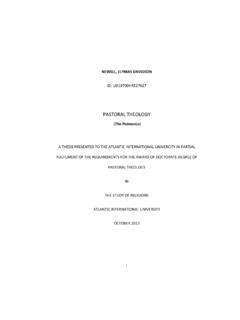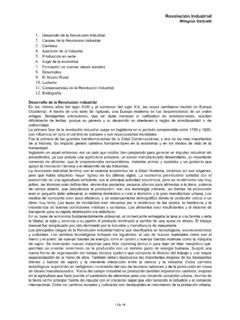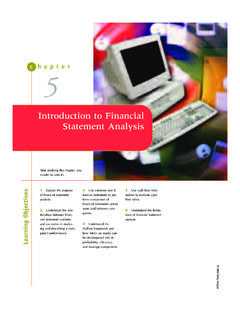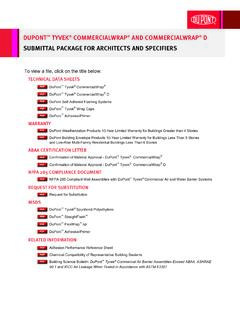Transcription of Strategic Management Assignment
1 Atlantic International University Strategic Management Assignment BUILDING AND SUSTAINING COMPETITIVE ADVANTAGE. By Jeff Bordes Atlantic International University Honolulu, Hawaii May 2009. Required Assignment for Bachelor Program 2. INTRODUCTION: PURPOSE OF THE TOPIC. Definitions: What is Strategic Management ? Strategic Management is the art, science and craft of formulating, implementing and evaluating cross-functional decisions that will enable an organization to achieve its Strategic Management is the process of managing in a way that is consistent with the corporate strategy or in such a way as to capitalize on the opportunities that present What is Competitive Advantage? A competitive advantage is an advantage over competitors gained by offering consumers greater value, either by means of lower prices or by providing greater benefits and service that justifies higher A firm has a competitive advantage when it implements a strategy competitors are unable to duplicate or find too costly to imitate.
2 An organization can be confident that its strategy has resulted in one or more useful competitive advantages only after competitors' efforts to duplicate its strategy have ceased of failed. The speed with which competitors are able to acquire the skills needed to duplicate the benefits of a firm's value-creating strategy determines how long the competitive advantages will 1. 1. Management 2. 3. 4. Michael A. Hitt et al. Management of Strategy: Concepts and Cases. 7 th ed. Thomson South-Western (2007, ). 3. Rationale for the Topic: In Bill Clinton's first presidential campaign, he was behind in every poll in his race for president. With allegations of sexual misconduct and philandering swirling around him, leading political analysts and columnists agreed that it was just a matter of days before he would be forced to drop out.
3 Then, employing an amazing strategy based on just four words "It's the economy, stupid! . "Clinton strategist James Carville turned it all around. Clinton concentrated on this short message to the exclusion of all else. This simple strategy led to defeat for George Bush and two terms for Clinton as president. Though living 2,500 years before the Clinton bid for the presidency, the Greek general Xenophon would have related to Carville's strategy and the ancient Chinese strategist Sun Tzu would also have understood it perfectly. If you examine why some businesses always seem to beat their competition, you will again and again find evidence of a thoughtful strategy. These companies seem to be able to take almost any product or service and go up against almost any competitor and win.
4 It doesn't make any difference whether they are a "learning organization." It doesn't matter whether they use "one-to-one marketing." If there is an economic downturn, these companies seem to either get out just in time, or somehow use the downturn to become even more profitable. Technological breakthroughs, which drive others into bankruptcy, always seem to help them. Shortages are turned to their advantage. Moreover, these winners are in every industry from cottage to high tech, and they come in all sizes, from giant corporations to home businesses. What all these winning companies share is their ability to overcome the competition in nearly every situation that crops up. But they share something else, and that is the reason that they are able to overcome their competition.
5 What these companies also share are identical principles that their leaders employ again and again. If common strategy principles could be codified, they would certainly be invaluable to business, because once revealed they could be used by others to repeat a success again and again. Strategy analysts have tried to find such principles in the past, especially those with a military bent. This is because the study of strategy started with warfare, and the concept that there are military principles for success in strategy has been accepted for several thousand years. It is perhaps for this reason that the very word "strategy" comes from the Greek word "strategos,". which means "the art of the general."5. 4. The rationale for choosing this topic is to explore the opportunities and routes available for firms to build competitive advantage over their rivals.
6 DESCRIPTION. Firms have long attempted to build competitive advantage through an infinite number of strategies. Competitive strategies are designed to help firms deploy their value chains and other strengths to build competitive advantage. Thus, in practice, each company formulates its specific competitive strategy according to its own analysis of internal strengths and weaknesses, the value it can provide, the competitive environment, and the needs of its customers. Although there are as many different competitive strategies as there are firms competing, three underlying approaches to building competitive advantage appear to exist at the broadest level. They are (1) low-cost leadership strategies, (2) differentiation strategies, and (3) focus strategies. These three broad types of competitive strategies have also been labeled generic strategies.
7 All three generic strategies are designed to achieve distinction relative to a rival. I shall attempt to examine how each generic type of competitive strategy can build competitive advantage. 2. GENERAL ANALYSIS. LOW-COST LEADERSHIP STRATEGIES. Low leadership strategies are based on a firm's ability to provide a product or service at a lower cost than its rivals. The basic operating assumption behind a low-cost leadership strategy is to acquire a substantial cost advantage over other competitors that can be passed on to consumers to gain a large market share. A low-cost strategy then produces competitive advantage when the firm can earn a higher profit margin than results from selling products at current market prices. In many cases, firms attempting to execute low-cost strategies aim to sell a product that appeal to an average customer in a broad target market.
8 Oftentimes; these products or services are highly standardized and not customized to an individual customer's tastes, needs, or desires. A central premise of the low-cost 5. Cohen, William A, The art of the strategist: 10 essential principles for leading your company to victory (2004, ). 5. leadership strategy is the following: By making products with as few modifications as possible, the firm can exploit the cost reduction benefits that accrue from economies of scale and experience effects. Low-cost leadership strategies can also flourish in service businesses as well. In these arenas, firms attempt to capture economies of scale in information systems, procurement, logistics and even marketing. Examples of firms that successfully used a low-cost leadership strategy to build competitive advantage include Whirlpool in washers and dryers, Black and Decker in power tools, BIC in ball point pens, Wal-Mart in retailing, Gillette in razor blades, Texas Instruments and Intel in semiconductors, Samsung in color television sets, Sharp in flat-panel screens and LCD technology, Citigroup in credit card services, Emerson Electric in power drives and tolls, and dupont in nylon and other synthetic fibers.
9 Building a Low-Cost Advantage The low-cost strategy is based on locating and leveraging every possible source of cost advantage in a firm's value chain of activities. Once a firm pursuing a low cost leadership strategy has discovered an important source of cost improvement and reduction, however, it must then seek new ways to lower its activity costs even further over time. In other words, the sources of low-cost advantage are not enduring or sustainable without continuous improvement and ongoing searches for improved process yields, streamlined product design, or more efficient means of delivering a service. Building a cost-based advantage thus requires the firm to find and exploit all the potential cost drivers that allow for greater efficiency in each value-adding activity.
10 A cost driver is an economic or technological factor that determines the cost of performing some activity. Important cost drivers that shape the low-cost leadership strategy include (1) economies of scale, (2) experience or learning curve effects, (3) degree of vertical integration, and even (4) location of activity performance. Firms can tailor their use of these cost drivers to build low-cost leadership across different value-adding activities. In pursuing a cost-based advantage, no firm can obviously ignore such product attributes as quality, service, and reliability. If it does, its offering may become so unacceptable that consumers will refuse to buy it or will buy it only if the price is reduced to a level below what is needed to sustain 6. profitability. A firm pursuing a cost-based advantage must therefore strive to achieve some degree of quality parity or proximity with other firms that have defined the standards of product quality valued by customers.















